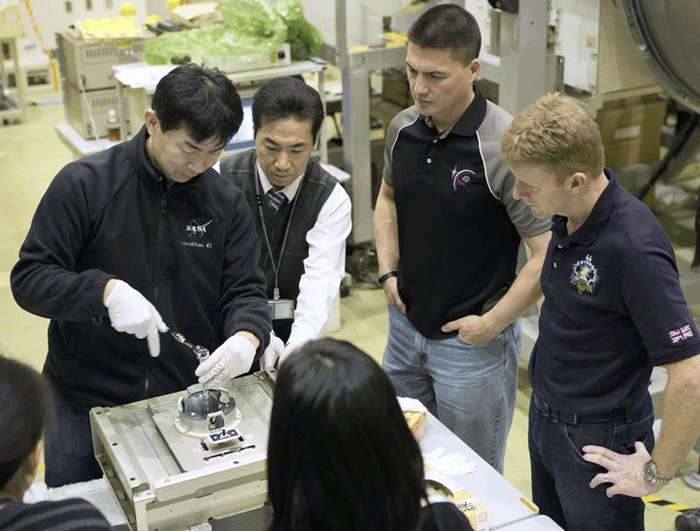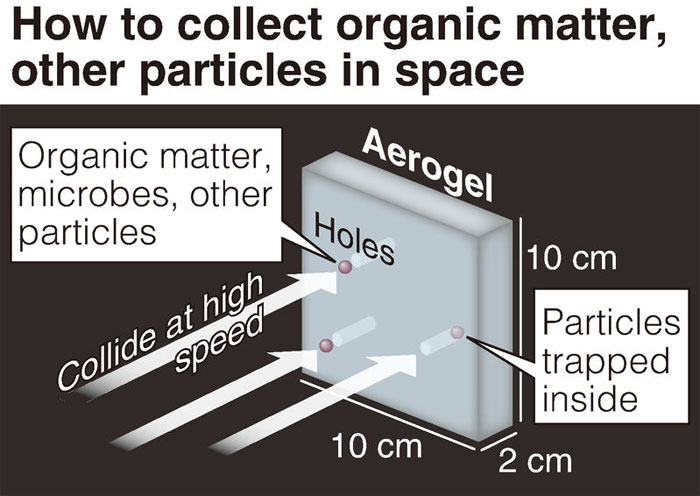.

Kimiya Yui, left, trains to conduct experiments for the Tanpopo mission at JAXA’s Tsukuba Space Center in Tsukuba, Ibaraki Prefecture, in mid-January.
.
Japan will begin a unique scientific project called the “Tanpopo mission” on the International Space Station (ISS), aiming to find and catch substances flying in space that may be the origin of life-forms.
The project will start in May in Kibo, Japan’s experiment module of the ISS.
The plan was suspended once due to the retirement of the U.S. space shuttles. But Japan’s own space development technologies and the enthusiasm of researchers paved the way to reviving the project about 10 years after it was first conceived.
The project will attach an absorbent called aerogel to the exterior of the Kibo module, which moves at high speeds 400 kilometers above the Earth, to collect space debris.
Resembling agar, the aerogel will be replaced every year. Researchers aim to catch organic matter — such as amino acids — drifting in space, and microbes that float from the Earth.
.

The Yomiuri Shimbun
.
Containers holding yeast and other microbes will also be placed outside the Kibo module to examine whether microbes can travel in space for a long time while being exposed to strong radiation rays and ultraviolet rays.
The project is set to start in May, the same month that 45-year-old Japanese astronaut Kimiya Yui is scheduled to arrive at the ISS for his first long-term stay in space. He has been trained to conduct experiments in the project.
The Tanpopo mission began to be considered in 2006, and it was initially scheduled to begin as early as 2011. However, the U.S. space shuttles were retired in 2011, and as a result the activities of astronauts outside the ISS have been strictly limited. The project was therefore suspended.
To revive the project, the Japan Aerospace Exploration Agency (JAXA) developed technologies for placing experimental devices outside the ISS with a robot arm. This paved the way for implementing the Tanpopo mission.
The project will be conducted by a team led by Prof. Akihiko Yamagishi, 62, of Tokyo University of Pharmacy and Life Sciences, an expert on microbiology. The team also comprises researchers from 26 universities and institutions in Japan, including JAXA.
The experiments will continue through 2018. The first samples are scheduled to be sent back to Earth in summer 2016 for analysis.
Yamagishi said: “I can leave the experiments to Mr. Yui with confidence. I hope this project will be the first step in unraveling how life-forms emerged on Earth.”
The Tanpopo mission aims to examine theories about the emergence of life-forms, including one that posits that their origins flew in from space. The project was named tanpopo (dandelion) because the plant’s seeds evoke the image of seeds of life-forms flying up to space.
Mice to be tested
Another team of researchers led by the National Institute of Radiological Sciences in Chiba has announced that it will conduct an experiment in which mouse embryos will be placed in the ISS for six months.
The experiment will examine the long-term effects of space radiation rays on the embryos.
Under the plan, 3,500 to 7,000 mouse embryos will be transported to the Kibo module of the ISS, where they will be stored in a freezer. The embryos will later be unfrozen on Earth, and the researchers will grow baby mice from the embryos. The researchers will check their life-spans and rates of developing cancer.
“We want to collect basic data for examining the effect on human bodies,” said Shizuko Kakinuma, the team leader and an expert on radiation biology.Speech
Quelle: The Japan Times
4400 Views
